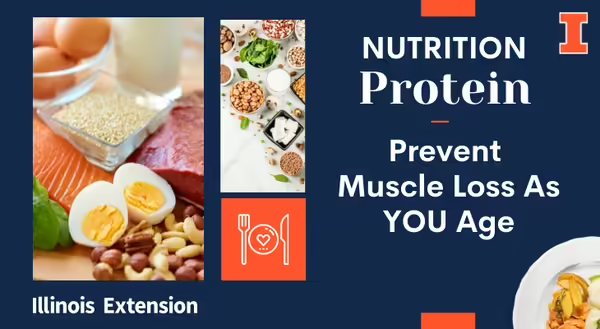
Eating healthy in addition to making sure you are getting adequate physical activity are critical in combating age-related muscle loss. We all know eating healthy is important. However, it is much easier said than done! And what exactly does it mean to eat healthy anyway?
Focus on key nutrients
Consuming nutrient-rich foods, foods rich in fiber, vitamins, and minerals and relatively low in calories, provide the body with sustenance and nourish our body. Fruits, vegetables, low-fat dairy, lean proteins, and whole grains, consumed as a balanced diet, promote health. Especially when paired with limited amounts of saturated fat, sodium, and added sugar.
But more importantly, nutrient-rich foods help us age well and preserve our muscle tissue. Let's look at protein, an essential nutrient needed to help prevent and maintain muscle.
Why are we talking about protein?
More than 1 in 3 adults, ages 51-60 years, are not meeting their recommended daily protein intake. And those 70 years and greater are consuming even less. This is unfortunate, considering how crucial dietary protein is to prevent age-related muscle loss.
Protein is made up of small molecules called amino acids. There are twenty different types of amino acids that combine to form protein, and each has a specific function. Some will help with growth and cell repair. Others will work in biochemical reactions, act as messengers, provide structure and transport and store nutrients throughout the body. Essentially, protein is truly the building block for life.
Thus, getting adequate dietary protein is key in maintaining muscle tissue and preventing muscle loss. Like carbohydrates and fat, dietary protein is a macronutrient and supplies the body with energy or calories. A macronutrient is a nutrient needed in more significant amounts than micronutrients, which we only need in small quantities.
The amount of protein needed depends on one's stage of life. Generally, during times of growth, injury, or illness, individuals will have relatively higher protein needs. However, as we age, our body becomes less effective at utilizing the protein consumed and less efficient at making new protein cells. Thus, we should be intentional about consuming protein-rich foods to maintain muscle mass and strength. Both plants and animals contain dietary protein.
Protein-rich foods
Whether you choose animal-based or plant-based proteins, include a variety of options and remember these healthy tips:
- Select lean proteins. Remove skin and trim away excess or added fat before baking or grilling.
- Poultry (skinless, white meat)
- Lean beef (tenderloin, sirloin, eye of round)
- Lean pork (tenderloin)
- Fish and seafood
- Choose non/low-fat dairy items and consider replacing regular yogurt with Greek yogurt, as it has a higher protein content.
- Skim or low-fat milk, yogurt, cheese, or cottage cheese
- Eggs
- Quinoa
- Beans, lentils, seeds, and nuts
As you read and take in the information above, it is my hope that it will give you greater insight into the why behind the dietary recommendations. And it will inspire you to reflect on the choices you are making daily. But more importantly, my wish for you is that it will compel you to take action, even if it is only a small step. The journey to wellness is a lifelong voyage. It is made up of many small steps, and as long as you are moving forward, even if you need to stop and rest for a while, you will be better off taking that one small step.
ABOUT THE AUTHOR: Diane Reinhold, MPH, MS, RDN, is a Nutrition and Wellness Educator with University of Illinois Extension, serving Jo Daviess, Stephenson, and Winnebago Counties. Diane is a registered dietitian nutritionist providing evidence-based programming focused on chronic disease prevention and management and food safety.
References
Krok-Schoen, J. L., Archdeacon Price, A., Luo, M., Kelly, O. J., & Taylor, C. A. (2019, February 19). Low dietary protein intakes and associated dietary patterns and functional limitations in an aging population: A NHANES analysis - The Journal of Nutrition, Health & Aging. SpringerLink. Retrieved May 4, 2022, from https://link.springer.com/article/10.1007/s12603-019-1174-1
U.S. National Library of Medicine. (n.d.). What are proteins and what do they do?: Medlineplus genetics. MedlinePlus. Retrieved May 3, 2022, from https://medlineplus.gov/genetics/understanding/howgeneswork/protein/#:~:text=Proteins%20are%20large%2C%20complex%20molecules,the%20body's%20tissues%20and%20organs.
What are proteins and what is their function in the body? Eufic. (2019, December 19). Retrieved May 4, 2022, from https://www.eufic.org/en/whats-in-food/article/what-are-proteins-and-what-is-their-function-in-the-body